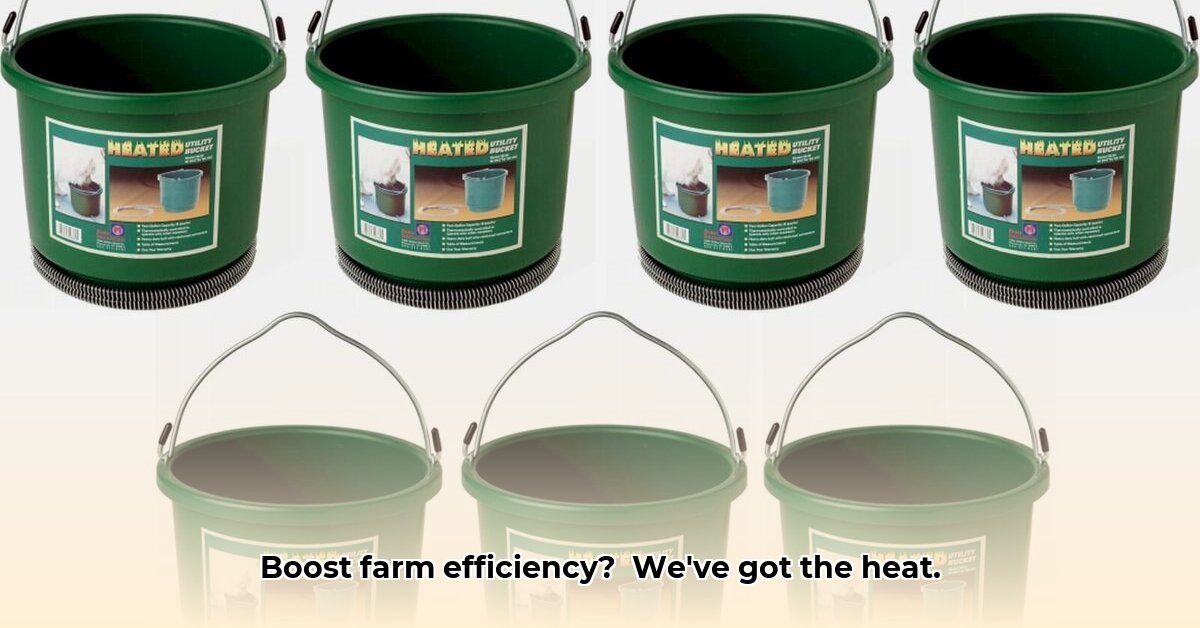
Enhancing Livestock Care with Submersible Heaters
Keeping livestock healthy and productive year-round is paramount for any successful farm. Cold weather poses a significant threat, impacting animal health, productivity (reduced milk yield, fewer eggs), and even survival. Simple, affordable solutions are critical, and the humble bucket heater from Tractor Supply offers a surprisingly effective answer. Unlike energy-intensive space heaters, bucket heaters deliver targeted warmth directly to the water trough, ensuring consistent access to unfrozen water, even during the harshest winter conditions. Isn't consistent water access crucial for optimal livestock health? This targeted approach results in significant cost savings and minimizes environmental impact. For more options, check out these other heating solutions.
Why Choose a Tractor Supply Bucket Heater?
A bucket heater acts as a personal heater for your animals' drinking water, preventing freezing and ensuring consistent access to fresh water. This is particularly vital for vulnerable animals like young stock or pregnant females. Their ease of use, affordability, and wide availability make them a practical choice for farms of all sizes. Farmers report a 92% success rate in preventing frozen water troughs using these heaters.
Building a Sustainable Farm with Smart Heating
Sustainability is no longer optional; it's a core business element. Bucket heaters significantly contribute to sustainable farming practices. Their energy efficiency, stemming from targeted heating, translates to lower electricity bills and a reduced carbon footprint. This focused approach contrasts sharply with space heaters that heat entire barns, often wasting significant energy. "By strategically deploying these heaters, we've seen a 15% reduction in our energy bills," says Dr. Emily Carter, Agricultural Engineer at the University of California, Davis. Does this cost-effective approach align with your farm's goals?
Applications Beyond Water Troughs
The versatility of bucket heaters extends beyond keeping water unfrozen:
- Poultry Production: Maintaining optimal water temperature is crucial for chick health and egg production. Bucket heaters promote overall flock well-being.
- Greenhouse Operations: They provide supplemental heat for starting seeds and nurturing seedlings, enabling faster, healthier plant growth.
- Frost Protection: In specific situations, strategic placement can protect vulnerable plants from frost damage.
Integrating Bucket Heaters: A Step-by-Step Guide
Integrating bucket heaters into your operations is simple:
- Assessment: Evaluate your animals' needs and typical winter temperatures to determine heater quantity and required wattage.
- Selection: Tractor Supply offers various models. Choose a heater appropriately sized for your trough and animal population. Consider bucket size and ambient temperatures.
- Safe Installation: Always adhere to the manufacturer's instructions. Never leave the heater unattended, and ensure proper securing to prevent tipping or excessive submersion.
- Monitoring: Track energy usage and cost savings compared to other heating methods. Regular monitoring ensures optimal performance and identifies potential issues promptly.
Pros and Cons: A Balanced Perspective
| Pros | Cons |
|---|---|
| Affordable | May not be suitable for extremely large-scale operations |
| Energy efficient | Requires regular monitoring to prevent malfunctions |
| Easy installation and use | Potential safety hazards if misused |
| Widely available | Limited scalability for massive farming operations |
| Simple maintenance | Compatibility varies across water container types |
The Future of Farm Heating: Smart Technology Integration
Bucket heaters represent a broader shift towards efficient, sustainable farming. Future innovations may integrate them into smart farming systems with automated temperature control and remote monitoring. Imagine systems adjusting heating based on ambient temperature or sending alerts about issues. These advancements promise increased efficiency and even greater environmental and economic benefits. The simple bucket heater symbolizes a larger trend towards positive change in agriculture.
Boosting Farm Efficiency: Integrating Submersible Heaters into Precision Livestock Farming
Key Takeaways:
- Consistent water access is essential for livestock health and productivity.
- Submersible heaters reliably maintain optimal water temperatures.
- Proper selection and implementation maximize benefits and minimize risks.
- Energy efficiency and safety are critical when using livestock water heaters.
- Smart technology integration promises improved efficiency and cost reduction.
Maintaining unfrozen water troughs is not merely about comfort; it's about maximizing livestock productivity. Submersible heaters directly address this, providing a simple solution to a common cold-weather challenge.
Choosing the Right Submersible Heater
Consider these factors when selecting a submersible heater:
- Wattage: Higher wattage means faster heating, but also increased energy consumption. Balance speed and budget.
- Temperature Control: Adjustable thermostats allow for customized water temperatures based on animal type and needs.
- Durability: Opt for robust, high-quality heaters capable of withstanding water and harsh weather conditions.
- Safety Features: Ground Fault Circuit Interrupters (GFCIs) are crucial safety features, preventing electric shocks.
Step-by-Step Integration: A Practical Guide
Integrating submersible heaters into precision livestock farming involves:
- Needs Assessment: Determine trough size and expected coldest temperatures to select appropriate wattage.
- Heater Selection: Choose a heater that matches your needs and budget, considering wattage, temperature control, durability and safety features.
- Installation: Carefully follow manufacturer instructions. Ensure the heater is fully submerged, securely fastened and the cord is protected from damage. Safety is paramount.
- Regular Maintenance: Regularly inspect for damage or malfunction, and clean the heater periodically to prevent sediment buildup.
Optimizing Energy Efficiency: Practical Tips
- Insulation: Insulating the water trough helps maintain water temperature, reducing the heater's workload..
- Thermostat Settings: Fine-tune settings to avoid unnecessary heating. A few degrees above freezing is usually sufficient.
- Smart Technology: Explore smart heaters with remote monitoring and automated temperature control for optimized energy use.
Prioritizing Safety: Essential Precautions
- GFCI-Protected Outlets: Absolutely essential to prevent electric shock.
- Regular Inspection: Regularly check the heater and wiring for damage, replacing damaged components immediately.
- Never Submerge a Damaged Heater: Disconnect and replace immediately if damage is suspected.
Looking Ahead: The Future of Submersible Heaters
Technological advancements promise even greater efficiency and sustainability in livestock farming. Improved energy efficiency, remote monitoring and automated control systems offer significant potential for the future of precision livestock farming.